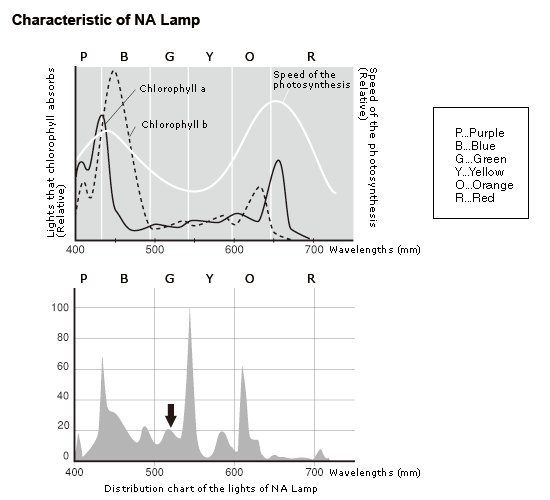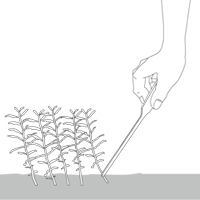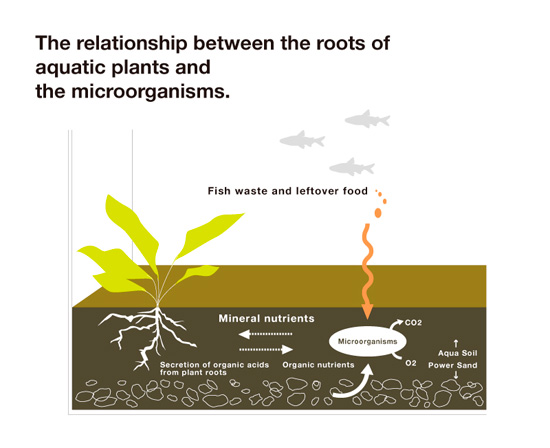Water always passes through a filter and circulates in an aquarium where an aquatic plant layout is created. The filter removes impurities that float in water, organic materials that cause cloudy water, and detoxifies ammonia, which is harmful to fish and shrimp, all with the help of bacteria. However, it is difficult to maintain aquarium water in continually clean state with the work of the filter alone. Frequent water changes become necessary since the water tends to get dirty, especially when the biological filter was not well established shortly after the aquarium has been set up.
Regular water changes will be needed thereafter to remove excessive nitrate and phosphate that build up in the water and cause algae to proliferate. A water change also has a benefit of keeping the inside of an aquarium physically clean. Through siphoning during a water change, the dirt and algae that collect on the substrate and on the surface of the leaves of aquatic plants are removed. Additionally, the photosynthesis of aquatic plants appears to become more active through an infusion of fresh water through a water change. The water change frequency should be every two to three days initially after an aquarium has just been set up. Once the filter has been established, the water quality can be maintained through weekly or biweekly water changes. The volume of water per water change should be approximately 1/3 of the total water volume.
Water Changes for Nature Aquarium
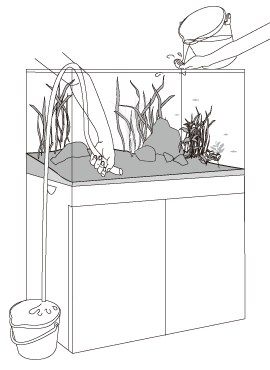 Water is drained with a hose (by siphon). Using various size hoses can make the work efficient, depending on the size of the aquarium and the purpose. Use a large diameter hose if the purpose is to drain water. A narrow hose is easier to use for suctioning out dirt in a tight area or sucking out algae. Algae on the glass surface should be cleaned before draining water. After 1/3 of the water is removed, adjust the temperature of the tap water and collect the water in a bucket. Remove residual chlorine in the water by adding Chlor-Off, and then pour the water into the aquarium. When changing water for a large aquarium, tap water can be added directly into the aquarium with a hose. However, be sure to adjust the temperature of the water and remove the residual chlorine.
Water is drained with a hose (by siphon). Using various size hoses can make the work efficient, depending on the size of the aquarium and the purpose. Use a large diameter hose if the purpose is to drain water. A narrow hose is easier to use for suctioning out dirt in a tight area or sucking out algae. Algae on the glass surface should be cleaned before draining water. After 1/3 of the water is removed, adjust the temperature of the tap water and collect the water in a bucket. Remove residual chlorine in the water by adding Chlor-Off, and then pour the water into the aquarium. When changing water for a large aquarium, tap water can be added directly into the aquarium with a hose. However, be sure to adjust the temperature of the water and remove the residual chlorine.The biological control of algae
The removal of algae is one of the purposes of a water change. However, it is difficult to eradicate all algae with it. During the first one to two weeks after an aquarium is set up, we must rely on water changes since the water quality problem precludes an addition of livestock. Once the water quality stabilizes, the use of certain livestock make algae control much easier. Yamato Numa Ebi (Caridina japonica) and Otocinclus are typical livestock that eat algae. Since they are good about eating diatoms that tend to develop during an initial set-up period of an aquarium, it would be nice to add them to an aquarium early. However, careful attention is required when adding them for the first time. Yamato Numa Ebi in particular is sensitive to the quality of water. It often will become lethargic on a piece of driftwood or a rock and will stop eating algae, or it dies from the effect of nitrite or residual chemicals remaining on the aquatic plants that have just been imported into the country. Frequent water changes are the only remedy in such cases. It is advisable to add just a few of these fish to an aquarium initially. More can be added later if they seem to be doing well. Adding a Siamese Flying Fox, which eats black beard algae, and Nerite snails, which eat green algae that grow on rock surfaces, in addition to Yamato Numa Ebi makes it easier to maintain a layout in a good condition.
Adding Fish to an Aquarium
When the water quality stabilizes in three to four weeks after the set-up of an aquarium, you can add fish that are the principal characters of a layout. We recommend that you check the water quality (nitrite and pH) before adding fish. If the biological filter is functioning properly, nitrite (NO2) will not be detected. If it is detected, it is advisable to wait before adding fish. Nitrite is highly toxic and harmful to fish. In an aquarium in which Aqua Soil is used as substrate, the pH may have dropped significantly. If the pH of the new aquarium is very different from that of the aquarium that fish came from, the fish may suffer from a pH shock. The fish’s eyes and slime coat on its body surface may turn cloudy, and the movement of its gills or the way it swims may become erratic. Therefore, the pH should also be checked before adding fish. If the pH of the water in the bag that store-bought fish came in and the pH of the new aquarium are very different, fish should be placed in a bucket after floating the bag in the aquarium to match the temperature and be acclimated to the new water by adding the tank water to the bucket gradually using airline tubing. If the fish is very sensitive to changes in water quality, the end of the airline tubing should be tied loosely so that the water drips slowly into the bucket.
Maintaining fish’s health
Regular water changes are essential for maintaining the health of fish. Water changes are performed safely by adding Chlor-Off, which removes harmful residual chlorine, and RIO BASE, which protects fish’s slime coating. Newly purchased fish may be weakened due to the stress of shipping. VITAMIX rich in vitamins and BLACK WATER that recreate the river water of tropical rainforests containing humic acid is effective for relieving the fish’s stress. Fish with damaged skin or mouths due to netting tend to suffer from bacterial infection if left untreated. We recommend adding Phyton Git that has an antiseptic property right after placing new fish to an aquarium to prevent such infection. Daily feeding is also essential for maintaining fish’s health. Highly digestible Fish Food AP that will not foul water or highly nutritious Fish Food AP Gold that will stimulate fishes’ appetite are suitable food for fish in Nature Aquarium. Both are available in three different granule sizes so that you can choose the right one depending on the size of your fish. The use of AP Glass makes feeding easy and neat.
Trimming Aquatic Plants
Overgrown aquatic plants are the biggest problem for maintaining Nature Aquarium. A hobbyist may worry that aquatic plants may not grow well in the beginning. However, once the growing conditions are met and aquatic plants start growing well, sooner or later the aquatic plants will fill up the entire space. This will destroy the composition of a layout and the swimming space for fish will be lost as well. This not only creates a problem for viewing, but it also causes the aquatic plants to decline in the lower parts where light does not reach well. Stem plants in particular grow very fast and fill up a space quickly. Therefore, they need to be trimmed early. Their stems should be trimmed to form bushes according to a desired composition. Repeated trimming promotes branching and their leaves become denser gradually. Although the plants do not look attractive right after trimming, they develop a lot of new buds in a short time and form beautiful bushes again. Glossostigma and Hair Grass that are often used in the foreground can be maintained by thinning their leaves through trimming. Scissors with curved tips are suitable for the trimming of these plants.
Creative Plant Rearrangement (Sozo Haishoku)
Even in Nature Aquarium that is created with long term maintenance in mind, when the condition of the substrate deteriorates, aquatic plants age and their growth becomes poor after a while. When this happens, an aquarium is often emptied out and a layout is recreated from a scratch. However, recreating a new layout through creative plant rearrangement (Sozo Haishoku) by leaving the frame of composition as is and planting new aquatic plants is another way to enjoy Nature Aquarium. Basically, Sozo Haishoku is limited to an Iwagumi layout in which its composition materials do not move easily. If you have an Iwagumi layout that you are pleased with, you can try for a variety of layout possibilities by changing aquatic plants. Here’s what you do: First, remove fish and shrimp from the aquarium and drain the water completely. Leave the rock arrangement in tact and remove the aquatic plants around it. If the substrate material is relatively new, add some Aqua Soil on the substrate surface and plant new plants. If the substrate is old, remove the Aqua Soil around the rocks carefully with a spoon or another tool so as not to move the rock arrangement. Place new Power Sand and Aqua Soil and plant with aquatic plants. I recommend that you give it a try as an ultimate way to enjoy Nature Aquarium.
Trimming Method
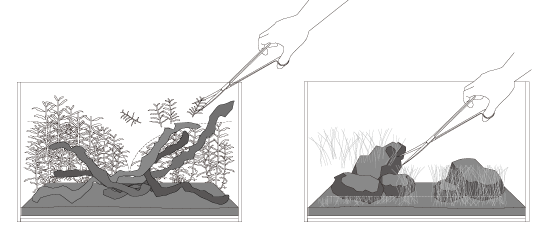
Trimming Scissors or Pro-scissors should be used for trimming depending on the type of aquatic plants and their placement. Stem plants can be trimmed relatively easily by shaping bushes with Trimming Scissors using driftwood as a guide. Curved Trimming Scissors or scissors with curved tips, such as Pro-Scissors ‘Nude’ or ‘Wave’, are easier to use when trimming Hair Grass short.




